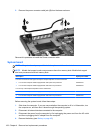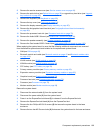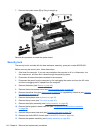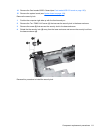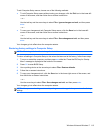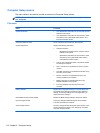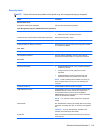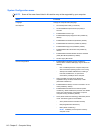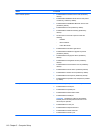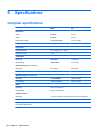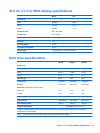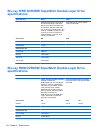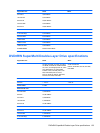
System Configuration menu
NOTE: Some of the menu items listed in this section may not be supported by your computer.
Select To do this
Language Change the Computer Setup language.
Boot Options
●
Set a Startup Menu delay (in seconds).
●
Set the MultiBook Express Boot Popup delay in
seconds.
● Enable/disable Custom Logo.
●
Enable/disable Display Diagnostic URL (enabled by
default).
●
Enable/disable CD-ROM boot (enabled by default).
●
Enable/disable SD Card boot (enabled by default).
● Enable/disable floppy boot (enabled by default).
●
Enable/disable PXE Internal NIC boot (enabled by
default).
● Enable/disable Unified Extensible Firmware Interface
(UEFI) Boot Mode (disabled by default).
●
Set the Legacy Boot Order.
Device Configurations
●
Enable/disable USB legacy support (enabled by
default). When enabled, USB legacy support allows the
following:
◦ Use of a USB keyboard in Computer Setup even
when a Windows operating system is not running
◦
Startup from bootable USB devices, including a
hard drive, diskette drive, or optical drive
connected by a USB port to the computer
● Select a parallel port mode: ECP (Enhanced
Capabilities Port), standard, bidirectional, or EPP
(Enhanced Parallel Port).
●
Enable/disable fan always on while connected to an AC
outlet (enabled by default).
●
Enable/disable Data Execution Prevention (select
models only). When enabled, the processor can disable
some virus code execution, which helps to improve
computer security (enabled by default).
● SATA (Serial Advanced Technology Attachment) device
mode. The following options are available:
◦ AHCI (Advanced Host Controller Interface)
◦ IDE (Integrated Drive Electronics)
◦
RAID (select models only)
NOTE: Availability of these options varies by
computer model.
116 Chapter 5 Computer Setup



